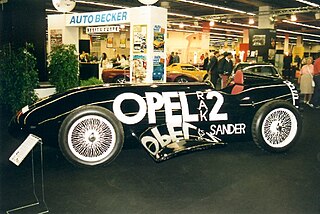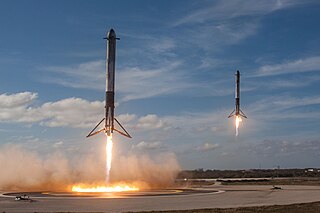Related Research Articles

A rocket is a vehicle that uses jet propulsion to accelerate without using any surrounding air. A rocket engine produces thrust by reaction to exhaust expelled at high speed. Rocket engines work entirely from propellant carried within the vehicle; therefore a rocket can fly in the vacuum of space. Rockets work more efficiently in a vacuum and incur a loss of thrust due to the opposing pressure of the atmosphere.

A hybrid-propellant rocket is a rocket with a rocket motor that uses rocket propellants in two different phases: one solid and the other either gas or liquid. The hybrid rocket concept can be traced back to the early 1930s.

This article gives a concise timeline of rocket and missile technology.

A hypergolic propellant is a rocket propellant combination used in a rocket engine, whose components spontaneously ignite when they come into contact with each other.

ThrustSSC, Thrust SSC or Thrust SuperSonic Car is a British jet car developed by Richard Noble, Glynne Bowsher, Ron Ayers, and Jeremy Bliss. Thrust SSC holds the world land speed record, set on 15 October 1997, and driven by Andy Green, when it achieved a speed of 1,228 km/h (763 mph) and it became the first and only land vehicle to officially break the sound barrier.

A spaceplane is a vehicle that can fly and glide like an aircraft in Earth's atmosphere and maneuver like a spacecraft in outer space. To do so, spaceplanes must incorporate features of both aircraft and spacecraft. Orbital spaceplanes tend to be more similar to conventional spacecraft, while sub-orbital spaceplanes tend to be more similar to fixed-wing aircraft. All spaceplanes to date have been rocket-powered for takeoff and climb, but have then landed as unpowered gliders.

A liquid-propellant rocket or liquid rocket uses a rocket engine burning liquid propellants. (Alternate approaches use gaseous or solid propellants.) Liquids are desirable propellants because they have reasonably high density and their combustion products have high specific impulse (Isp). This allows the volume of the propellant tanks to be relatively low.

SABRE is a concept under development by Reaction Engines Limited for a hypersonic precooled hybrid air-breathing rocket engine. The engine is designed to achieve single-stage-to-orbit capability, propelling the proposed Skylon spaceplane to low Earth orbit. SABRE is an evolution of Alan Bond's series of LACE-like designs that started in the early/mid-1980s for the HOTOL project.
High-test peroxide (HTP) is a highly concentrated solution of hydrogen peroxide, with the remainder consisting predominantly of water. In contact with a catalyst, it decomposes into a high-temperature mixture of steam and oxygen, with no remaining liquid water. It was used as a propellant of HTP rockets and torpedoes, and has been used for high-performance vernier engines.
Motors for model rockets and high-powered rockets are classified by total impulse into a set of letter-designated ranges, from ⅛A up to O. The total impulse is the integral of the thrust over burn time.

Cornwall Airport Newquay is the main commercial airport for Cornwall, England located at Mawgan in Pydar, 4 NM northeast of the town of Newquay on Cornwall's north coast. Its runway was operated by RAF St Mawgan before 2008, and is now owned by Cornwall Council and operated by Cornwall Airport Ltd.
Amateur rocketry, sometimes known as experimental rocketry or amateur experimental rocketry, is a hobby in which participants experiment with fuels and make their own rocket motors, launching a wide variety of types and sizes of rockets. Amateur rocketeers have been responsible for significant research into hybrid rocket motors, and have built and flown a variety of solid, liquid, and hybrid propellant motors.
Ronald Frederick Ayers was an English engineer who was responsible for the aerodynamics of the land speed record-holding vehicles, ThrustSSC and JCB Dieselmax, and was Chief Aerodynamicist for the Bloodhound SSC.

The Rocket Propulsion Establishment at Westcott, Buckinghamshire on the site of the former RAF Westcott has made a number of notable contributions in the field of rocket propulsion, including input on the rocket design for the Blue Streak missile and the propulsion systems on Chevaline. It was also known as the Guided Projectiles Establishment and PERME Westcott.

A rocket car is a land vehicle propelled by a rocket engine. A rocket dragster is a rocket car used for competing in drag racing, and this type holds the unofficial world record for the 1/4 mile.
Bloodhound LSR, formerly Bloodhound SSC, is a British land vehicle designed to travel at supersonic speeds with the intention of setting a new world land speed record. The arrow-shaped car, under development since 2008, is powered by a jet engine and will be fitted with an additional rocket engine. The initial goal is to exceed the current speed record of 763 mph (1,228 km/h), with the vehicle believed to be able to achieve up to 1,000 miles per hour (1,609 km/h).
Nitrous oxide fuel blend propellants are a class of liquid rocket propellants that were intended in the early 2010s to be able to replace hydrazine as the standard storable rocket propellent in some applications.

Falcon Heavy is a heavy-lift launch vehicle with partial reusability that can carry cargo into Earth orbit, and beyond. It is designed, manufactured and launched by American aerospace company SpaceX.

Delft Aerospace Rocket Engineering is a student-run society within Delft University of Technology, with over 190 members. The main focus of the student group is the development of rocket technology on a non-profit basis. All development, from engines to electronics, is done in-house. Although several projects take place in DARE, the group's two flagship projects are Stratos and Project Sparrow. Stratos includes the Stratos I rocket which was launched in 2009 and set the European altitude record for amateur rocketry at 12.5 km. The follow-up of this rocket was the Stratos II+, which was launched on 16 October 2015, reaching an altitude of 21.5 km and breaking the European altitude record. In summer of 2018, Stratos III was launched, disintegrating 20 seconds after the launch. Its successor, Stratos IV, was set to launch to 100 km, but never did due to ground systems failures during the launch campaign. Project Sparrow successfully developed a LOX/Ethanol, regeneratively cooled engine, and Stratos V, the latest flagship project, is building a reusable rocket around it. Even though DARE cooperates with the military to safely conduct launch campaigns, DARE's technology is strictly non-military. Approximately 70 percent of members come from the Faculty of Aerospace Engineering of Delft University of Technology, with the remaining 30% coming from other faculties, including Mechanical Engineering, Electrical Engineering, Applied Physics and Industrial Design. DARE also features a very high number of international students, with about half of the students coming from outside the Netherlands.

The following outline is provided as an overview of and topical guide to rocketry:
References
- 1 2 3 4 Pavia, Will. Rocket Man set to become Record Man [ dead link ], The Times , 17 November 2008. Accessed 15 December 2008.
- ↑ Parrish, John. Rocket Boy, The People , 31 January 1999. Accessed 16 December 2008.
- ↑ The Team, bloodhoundssc.com. Accessed 16 December 2008. Archived 8 July 2011 at the Wayback Machine
- ↑ Raw Talent: The Rocket Scientist, British Film Institute. Accessed 16 December 2008.
- ↑ , UKRA.
- ↑ The Hybrid Rocket for Bloodhound SSC and Inspiring the Next Generation, ICT Evening Seminar 2013 - Daniel Jubb. Accessed 5 January 2014.
- ↑ Satter, Raphael. British engineers announce plans for rocket car, AJC Cars, 4 November 2008. Accessed 15 December 2008.
- ↑ Amos, Jonathan. Supersonic car targets 1,000mph, BBC News , 22 October 2008. Accessed 15 December 2008.
- ↑ Birch, Stuart. Rocket, gas turbine, and V12 to power speed bid Archived 19 January 2009 at the Wayback Machine , 5 December 2008. Accessed 16 December 2008.
- ↑ BBC, Science Section. Newquay test set for Bloodhound land speed rocket, BBC News , 12 September 2012. Accessed 31 December 2013.
- ↑ YouTube video from The Telegraph of the Newquay, GB test firing. , 12 September 2012. Accessed 2 January 2014.
- ↑ bloodhoundssc.com. Bloodhound SSC Vehicle Technical Specification: configuration 11, June 2012, June 2012. Accessed 3 January 2014.
- ↑ bloodhoundssc.com. Monopropellant rocket testing underway, A successful static test of the 44.5 kN (10,000 lb) thrust monopropellant chamber was conducted on 12 July., 27 July 2009. Accessed 3 January 2014.
- ↑ Neil Armstrong visits the BLOODHOUND Technical Centre. Accessed 6 January 2014.
- ↑ British Forces News TV report 2:12. Accessed 16 January 2014.
- ↑ "Bloodhound 1,000mph car to use Norwegian Nammo rocket". BBC News. 19 December 2013.
- ↑ Fastest Tache in Britain Archived 12 June 2010 at the Wayback Machine , The Chap , 3 April 2009. Accessed 28 October 2010.